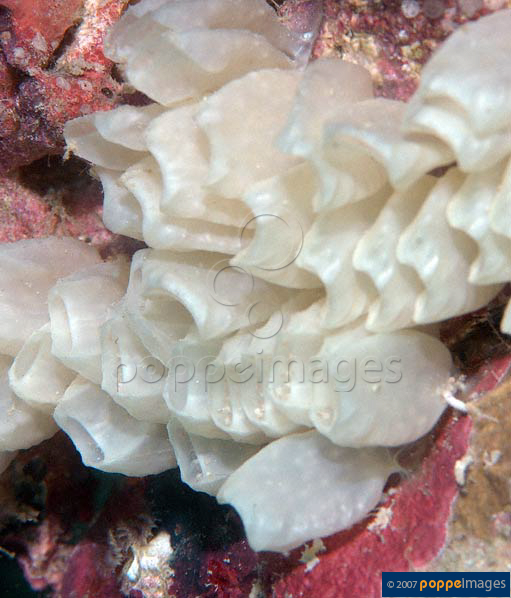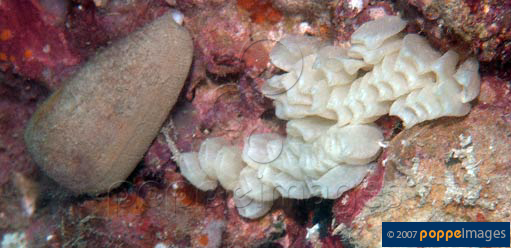The Birds and The Bees
Both images provided by © 2011 Guido & Philippe Poppe - www.poppe-images.com.
 There
is a lack of research on the reproduction and life cycle of
Conus magus, therefore, the information that is known about
these organisms has yet to be fully confirmed. At this point it is
understood that the species possess a dioecious lifestyle, meaning
that each individual produces solely sperm or solely eggs. In other
words, they are males and females opposed to the hermaphroditic
lifestyle that other snails partake in. Although they typically live
solitarily, a male and female snail will come together once a year
and mate through internal fertilization. Soon after, the female snail
will lay several capsules each with a varying number of eggs. Eggs
are laid in great numbers because the majority will not survive past
the first few days of life. The capsules attach to the substrate in
a cluster where they will remain for anywhere between one and fifty
days. The eggs hatch and from there the hatchlings will grow into
mature adults. The eggs that do make it to the mature adult stage
will live for anywhere between ten and fifteen years.
There
is a lack of research on the reproduction and life cycle of
Conus magus, therefore, the information that is known about
these organisms has yet to be fully confirmed. At this point it is
understood that the species possess a dioecious lifestyle, meaning
that each individual produces solely sperm or solely eggs. In other
words, they are males and females opposed to the hermaphroditic
lifestyle that other snails partake in. Although they typically live
solitarily, a male and female snail will come together once a year
and mate through internal fertilization. Soon after, the female snail
will lay several capsules each with a varying number of eggs. Eggs
are laid in great numbers because the majority will not survive past
the first few days of life. The capsules attach to the substrate in
a cluster where they will remain for anywhere between one and fifty
days. The eggs hatch and from there the hatchlings will grow into
mature adults. The eggs that do make it to the mature adult stage
will live for anywhere between ten and fifteen years.
When it comes to reproduction only the snails that are thriving in the environment get to partake. This way the certain qualities that are helpful to the species become stronger and eventually the species as a whole will have made the adaptation. Learn more about the adaptations made by Conus magus in Successful Snails.
Return Home.
Created by Kayla Haas, BIO 203 To Check out other organism websites visit University of Wisconsin-La Crosse www.multipleorganisms.net www.uwlax.edu
